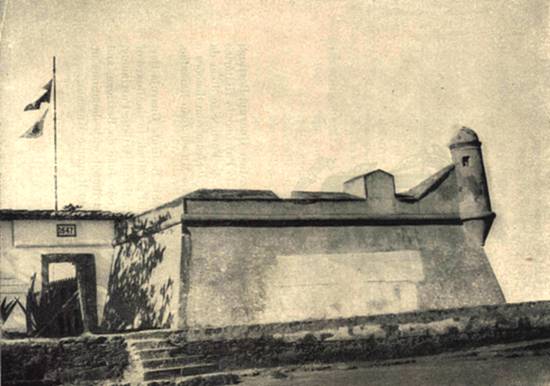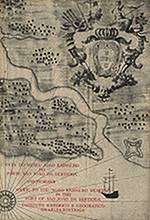|

Fort of São João da Bertioga – Main entrance
Foto publicada na página 16 do livrete
Fort of São João da Bertioga
(Ancient Fort of São Tiago)
BERTIOGA – 1531 – Bertioga holds an important place in the History of Brazil, for it was there that Martim Afonso de Souza anchored, in 1531, before going on to São Vicente, where he settled
in 1532, starting the civilization that was the basis for the formation of our country.
JOÃO RAMALHO – 1532 – After colonization had begun, Martim Afonso de Souza sent João Ramalho to Bertioga with some armed men, to verify the possibility of establishing a fort as the main
defense against the invasions of Tamoio Indians who, coming from Iperoig and Maembique (today known as Ubatuba and São Sebastião) could get to the new village of São Vicente through the channel.
BRAGA BROTHERS – 1532 – Among other Portuguese men who went to Bertioga with João Ramalho was Diogo de Braga, a notable figure in the forming and the defense of Bertioga; he took along his
indian wife and four sons, who came to be the first colonizers to be namely cited by variouns historians, all of whom recognized their efforts in the construction of the primitive palisade, in the development of a sugar-cane farm and in the defense
of the new center against the assaults of wild Indians.
FORT OF SÃO TIAGO – 1547 – After a fight in which all but 8 christians were slaughtered by the Indians, it became clear that it was necessary to build a fort which would permit a stronger
resistance against assaults of the enemies, and so the Braga brothers, together with the survivors and some new colonizers built the foundations of the Fort of São Tiago, in the same place where the primitive palisade had stood.
FORT OF SÃO FELIPE – 1550 – By royal command, effected by Braz Cubas, a fort was erected on the other side of Bertioga channel, in the island of Santo Amaro and named São Felipe.
HANS STADEN – 1550 – The lord-high constable of this primitive fortress was a German gunner, Hans Staden, employed by Gov. General Tomé de Souza. Both forts (São Tiago and São Luis), with
their crossed fires, were a real help in the defense of the colony against indian and foreign incursions.
RECONSTRUCTIONS – 1557/1560 – In the year of 1557 the Fort of São Tiago was rebuilt, reinforced and enlarged. The work was done by a Portuguese nobleman, Antonio Rodrigues de Almeida; the
Fort of São Felipe was reconstructed 3 years later, though the Governor of the Province, Captain Jorge Ferreira had determined the work to be done at the same time as the Fort São Tiago.
ARMISTICE OF IPEROIG – 1563/1564 – Leaving from Santos and stopping at Bertioga, Padre Nóbrega and Padre Anchieta went to Iperoig on an expedition at the expenses of the Adorno brothers, one
of whom went along with the priests to try to pacify the Tamoio Indians. Padre Anchieta stayed in Iperoig as hostage and through his faith and moral strength, attained the much sought-after peace.
FOUNDATION OF RIO DE JANEIRO – ESTÁCIO DE SÁ, ANCHIETA, NÓBREGA, ADORNOS – 1565 – After Mass said by Padre Manuel da Nóbrega, José de Anchieta left Bertioga accompanied by
the Adorno brothers. Estácio de Sá had sent word that he needed help in Rio de Janeiro, the Adorno brothers provided several vessels and oar-boats, with their respective christian and indian crews and so it was possible for them to aid the first
retaking of Rio de Janeiro. Help also came from São Vicente and Bahia.
SECOND EXPEDITION – 1567 – Once more they started from Bertioga, in 1567, but this time equipped with better boats and men. Their help was decisive to Mem de Sá and Estácio de Sá in the fight
for the final occupation of Rio de Janeiro. The efforts of these pioneers, and specially of Padre José de Anchieta, were very effective in the expulsion of the French and their allies.
ARTILLERY – 1761 – The new arms were the 3 historical cannons which are exhibited at the Museum.
FORT OF SÃO LUÍS – 1765 – In 1765 the Fort of São Felipe was reconstructed and its name changed to São Luís, in honor of Governor D. Luís Antônio de Sousa.
FORT OF SÃO JOÃO DA BERTIOGA – 1765 – The changing of the name of Fort São Tiago to Fort São João da Bertioga was effected because of the Chapel dedicated to São João and which had been built
during restorations made in the Fort in earlier years.
GARRISON – 1772 – In 1772 the Fort of São João da Bertioga had a complete garrison of soldiers, from which patrols were sent to São Sebastião and Ubatuba.
GROUND-PLAN OF THE FORT - 1817 – A ground-plant of the Fort was made by Rufino José Felizardo e Couto, by command of the Governor of the province, Count of Palma. Rufino José, studying the
plans for reforms and enlargements to be made at the fort, wrote in his report: "There are in this fort 9 cannon, all made of cast iron and of these only 3 are still usable: one caliber-6, which is the best of the three, and two caliber 9."
RESTORATION – 1945 – The fort of São João da Bertioga was restored by command of the Board of Directors of the National Historical & Artistic Patrimony, who ordered its supports and
foundations reforced.
JOÃO RAMALHO MUSEUM – 1962 – Through an agreement between the Historical and Geographical Institute of Guarujá-Bertioga and the Board of Directors of the National
Historical and Artistic Patrimony, the House of the Fort was completely restored permitting the installation of the João Ramalho Museum, to perpetuate the glories of our past.
Celso Corrêa Dias
Director-Secretary.

Ground-plan of the Fort of São João da Bertioga, in 1817. (see nº 24 in the Catalogue). Note: During the restorations effected in 1961, by the Board of Directors of the
Historical and Artistic Patrimony, with the aid of the Historical and Geographic Institute of Guarujá-Bertioga, it was not possible to recompose entirely the ruins of the Fort as seen on this plant. This will be done when new donations are granted. (N.E.: correct is number 23)
Foto publicada na página 17 do livrete
|



